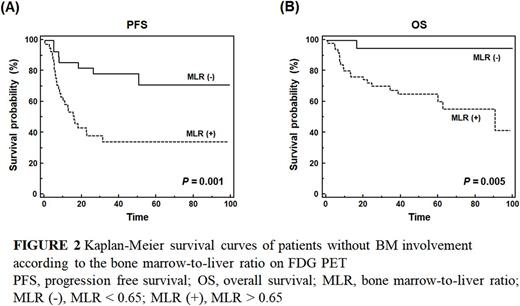Abstract
Objective: We investigated clinical value of FDG PET for evaluation of bone marrow (BM) tumor involvement status in peripheral T cell lymphoma (PTCL) or extranodal NK/T cell lymphoma (NKTCL).
Methods: Patients with PTCL or NKTCL, who underwent initial staging with FDG PET and BM biopsy were analyzed. PET BM uptake was analyzed visually and quantitatively (bone marrow-to-liver ratio; MLR). Receiver-operating-characteristic (ROC) analysis was performed to evaluate the usefulness of FDG PET for predicting BM tumor involvement. Prognostic implication of FDG PET finding was also assessed.
Results: A total of 109 (63 PTCL and 46 NKTCL) patients were analyzed. BM biopsy revealed tumor involvement in 64.2% of cases. In the ROC curve analysis for determining visually positive BM involvement by MLR, the area under curve (AUC) was 0.948 with sensitivity 90.2% and specificity 91.2%. The AUC using visual analysis was 0.76 (sensitivity 82.1% and specificity 38.6%). Predicting power of FDG PET for BM involvement was not different across lymphoma subtypes. Multivariate survival analysis revealed that BM FDG PET finding was an independent prognostic factor for survival in PTCL and NKTCL. Moreover, MLR was a significant prognostic factor for both PFS and OS (P = 0.001 and 0.005) in BM involvement-negative patients by BM biopsy.
Conclusion: Although FDG PET findings fairly correlates with BM biopsy findings, FDG PET could not replace BM biopsy in PTCL and NKTCL. Rather, BM finding on FDG PET is an independent prognostic factor in these tumors, suggesting further biologic relevance of FDG PET findings.
No relevant conflicts of interest to declare.
Author notes
Asterisk with author names denotes non-ASH members.


This feature is available to Subscribers Only
Sign In or Create an Account Close Modal